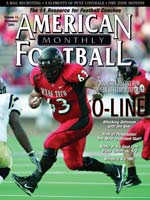AMERICAN FOOTBALL MONTHLY THE #1 RESOURCE FOR FOOTBALL COACHES
Article CategoriesAFM Magazine
|
Time of Possession: The most important statistic?There are 24 official statistics measured by the NCAA - from total offense to turnover differential - but maybe the most important one isn\'t trackedby: Terry Jacoby © More from this issue All football coaches would agree that the most important statistic is the one flashing on the scoreboard at the end of the game. But there are other statistics that help contribute to that final result up on the big board to the right and left of the zeros. Is time of possession one of them? High school and college coaches might disagree on the final answer, but they all believe that time of possession is something to keep an eye on. Valdosta State Coach Chris Hatcher has the highest winning percentage (.894) among active coaches in college football who have coached at least five years. He is 43-2 in the Gulf South Conference and his Blazers were National Champions in Division II last season. Hatcher and his team won the national title last year despite losing its first game of the season, 24-22 to Albany State Univers....The full article can only be seen by subscribers. Subscribe today!
|
|
|||||||
| HOME |
MAGAZINE |
SUBSCRIBE | ONLINE COLUMNISTS | COACHING VIDEOS |
Copyright 2025, AmericanFootballMonthly.com
All Rights Reserved





